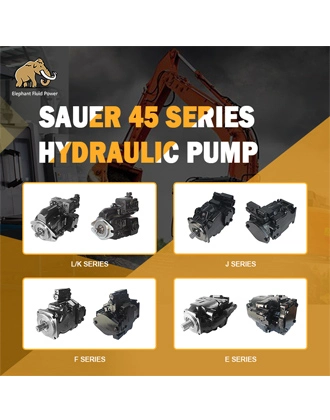Fixed displacement radial piston pump, as a key device in hydraulic systems, is widely used in various application scenarios due to its high volumetric efficiency and stable performance. This article will delve into the common causes of failure of the fixed displacement radial piston pump, analyze its application effects through practical case studies, to help users better understand and maintain this important equipment.
Working Principle of the Fixed Displacement Radial Piston Pump
The working principle of the fixed displacement radial piston pump is based on the reciprocating motion of the piston within the pump cylinder. This motion causes volume changes between the piston and the pump wall, resulting in repeated suction and discharge of the liquid within the pump, thereby increasing the pressure. Compared to other types of pumps, its volumetric efficiency can reach 0.92~0.98, and it can operate stably under pressures as high as 35MPa. Its design allows the fixed displacement radial piston pump to have low pressure pulsation in output flow and effectively adjust displacement, making it suitable for applications requiring high pressure, large flow, and flow regulation, such as construction machinery and aerospace fields.
Common Failures and Cause Analysis
In practical use, the fixed displacement radial piston pump may encounter a variety of failures that affect its performance and lifespan. Here are several common failures and their causes:
Reduced Output Flow
When the fixed displacement radial piston pump experiences reduced output flow, it is usually due to an increased clearance in the piston hole or wear on the ball head. Piston wear or increased clearance will cause oil leakage, leading to a drop in pump flow. Additionally, poor sealing of the check valve outlet or a broken spring piston can also cause similar problems.
Increased Noise
If the fixed displacement radial piston pump emits abnormal noise during operation, it may be due to friction or damage between the bearings and the drive shaft. Prolonged use of the pump can lead to bearing temperature rise and wear, affecting the normal operation of the pump. Furthermore, the quality of the hydraulic oil is another important factor that can cause increased noise.
Unstable Operation
The fixed displacement radial piston pump may exhibit unstable operation typically due to insufficient cleanliness of the oil in the pump, or wear and aging of components such as pistons and valve plates. Regular replacement of hydraulic oil and cleaning of the oil tank can effectively prevent these problems from occurring.
Application Case Analysis of the Fixed Displacement Radial Piston Pump
In the aerospace field, the fixed displacement radial piston pump is widely used due to its high volumetric efficiency and stability. For example, a certain airline uses the fixed displacement radial piston pump which shows excellent reliability and durability in high-pressure environments. With regular maintenance and proper operations, these pumps can maintain stable performance under high-intensity working conditions, ensuring the safe operation of aircraft.
In the field of construction machinery, the fixed displacement radial piston pump also plays an important role. For example, a large construction company's excavator uses the fixed displacement radial piston pump to provide efficient hydraulic drive. After extensive practical operation, the pump performs stably and requires infrequent maintenance, providing strong assurance for the company's project progress.
 French
French
 Portuguese
Portuguese
 Russian
Russian
 German
German
 Spanish
Spanish
 Japanese
Japanese
 Korean
Korean
 Irish
Irish
 Greek
Greek
 Turkish
Turkish
 Italian
Italian
 Danish
Danish
 Romanian
Romanian
 Indonesian
Indonesian
 Czech
Czech
 Afrikaans
Afrikaans
 Swedish
Swedish
 Polish
Polish
 Basque
Basque
 Catalan
Catalan
 Esperanto
Esperanto
 Hindi
Hindi
 Lao
Lao
 Albanian
Albanian
 Amharic
Amharic
 Armenian
Armenian
 Azerbaijani
Azerbaijani
 Belarusian
Belarusian
 Bengali
Bengali
 Bosnian
Bosnian
 Bulgarian
Bulgarian
 Cebuano
Cebuano
 Chichewa
Chichewa
 Corsican
Corsican
 Croatian
Croatian
 Dutch
Dutch
 Estonian
Estonian
 Filipino
Filipino
 Finnish
Finnish
 Frisian
Frisian
 Galician
Galician
 Georgian
Georgian
 Gujarati
Gujarati
 Haitian
Haitian
 Hausa
Hausa
 Hawaiian
Hawaiian
 Hebrew
Hebrew
 Hmong
Hmong
 Hungarian
Hungarian
 Icelandic
Icelandic
 Igbo
Igbo
 Javanese
Javanese
 Kannada
Kannada
 Kazakh
Kazakh
 Khmer
Khmer
 Kurdish
Kurdish
 Kyrgyz
Kyrgyz
 Latin
Latin
 Latvian
Latvian
 Lithuanian
Lithuanian
 Luxembourg
Luxembourg
 Macedoniar
Macedoniar
 Malagasy
Malagasy
 Malay
Malay
 Malayalam
Malayalam
 Maltese
Maltese
 Maori
Maori
 Marathi
Marathi
 Mongolian
Mongolian
 Burmese
Burmese
 Nepali
Nepali
 Norwegian
Norwegian
 Pashto
Pashto
 Persian
Persian
 Punjabi
Punjabi
 Serbian
Serbian
 Sesotho
Sesotho
 Sinhala
Sinhala
 Slovak
Slovak
 Slovenian
Slovenian
 Somali
Somali
 Samoan
Samoan
 Scots Gaelic
Scots Gaelic
 Shona
Shona
 Sindhi
Sindhi
 Sundanese
Sundanese
 Swahili
Swahili
 Tajik
Tajik
 Tamil
Tamil
 Telugu
Telugu
 Thai
Thai
 Ukrainian
Ukrainian
 Urdu
Urdu
 Uzbek
Uzbek
 Vietnamese
Vietnamese
 Welsh
Welsh
 Xhosa
Xhosa
 Yiddish
Yiddish
 Yoruba
Yoruba
 Zulu
Zulu







